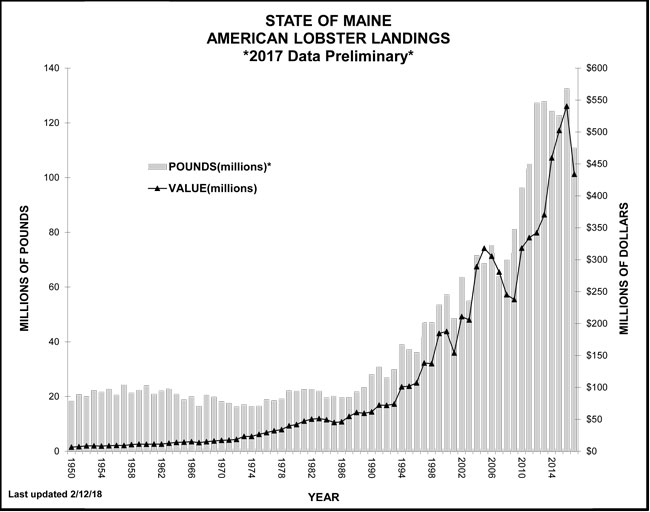Lobster Landings Down, Sky Not Falling
by Laurie Schreiber

Rick Wahle, UMaine School of Marine Sciences. “Studies indicate a tremendous disconnect between these huge levels of egg production and the downturn in settlement in the past several years.” Fishermen’s Voice photo
ROCKPORT—Lobster landings in 2017 declined by 16 percent from 2016.
Nevertheless, landings were the sixth highest on record at 110.8 million pounds, according to the Department of Marine Resources (DMR).
Value also dropped, from $4.08 a pound in 2016 to $3.91 per pound for an overall value of $433.8 million, which still represented the fourth highest landed value.
When accounting for bonuses paid to harvesters by 15 of 20 lobster co-ops, the overall landed value of lobster was $450.8 million.
According to National Marine Fisheries Service (NMFS) data, lobster was the species of highest landed value in the U.S. in 2015 and 2016. Maine’s landings accounted for approximately 80 percent of that landed value in 2016.
At the Maine Fishermen’s Forum in early March, DMR staffers said that June and July were the months that have been different over the last couple of years, with 2012, 2013, and 2016 considered earlier than usual for landings. Other months were on par. Landings in some areas, especially eastern Maine, are steadily increasing.
DMR scientist Robert Russell said studies show that lobster “young of the year” were down in 2017. That makes the fourth year the juvenile count was below average. Still, he said, it’s not a falling-sky situation.
“We’re in a low period, but we’re not that far off from where our long-term averages are,” Russell said.
Questions that arise, he said, include whether juveniles are actually not there, or whether they’re in a different location. Juveniles require a certain water temperature for optimal settlement, he said: “If they don’t get it, they look for another spot.”
Gulf of Maine’s warming waters could be causing juveniles to settle in new spots, he said.
Katherine Thompson, who coordinates the DMR’s sea sampling and ventless trap survey programs, said the sea sampling program is the DMR’s longest-running data set for lobster, started in 1985. The study shows the catch per trap of sublegal size lobsters, from 2005 to 2010, was fairly even across zones. From 2011 to 2016, that number was quite a bit higher. And in 2017, sublegals were up again in all zones except Zone F.
“So overall, we’re seeing an increasing trend in sublegal lobsters,” Thompson said.

The DMR’s ventless trap survey, started in 2006, targets juvenile lobsters by blocking escape vents. Operating from June through August, in random stratified sites in coastal waters, the study shows that, for sublegal lobsters, there were peaks in 2012 and 2016, which represented years of warmer water temperatures.
In 2017, sublegal catches were down slightly compared with 2016, but did not reach all-time lows. In eastern Maine, sublegal catches were slightly higher in deeper water in 2017.
“So overall, we see subtle trends of more sublegals in deeper water in all regions,” she said.
The DMR’s lead lobster scientist, Kathleen Reardon, described the Maine-New Hampshire Inshore Trawl Survey, performed along the coastal waters of Maine and New Hampshire since the fall of 2000 and designed to provide indices of abundance of multiple species. The survey shows there’s an increasing trend of sublegals over time, a finding that’s in keeping with the ventless trap survey.
Conversely, said Rick Wahle, a research professor with the University of Maine’s School of Marine Sciences, another study called the lobster settlement index, conducted by UMaine and the DMR, shows an apparent downturn in lobster larvae settlement. However, record levels of egg production showing up in other studies could imply that settlement is occurring outside of habitat where settlement has been found in the past, he said.
“Are low settlement
densities an artifact
of expanding
nursery habitat in
a warming ocean?”
– Rick Wahle
From Rhode Island to Nova Scotia, Wahle said, “The basic takeaway is that the Gulf of Maine is still well below average densities for larval settlement. That goes for Massachusetts and New Brunswick, too. So the question is, Is this a real signal? Has there been elevated larval mortality that’s translated then to declining levels of settlement? Or is it a question of, we’re not looking in the right place, or there’s expanded habitat?”
With regard to larval mortality, he said, New Hampshire fishery regulators have maintained a larval time series going back to the late 1970s, offshore the Seabrook nuclear power plant as part of the state’s impact monitoring studies. Taken together, Wahle said, studies indicate “a tremendous disconnect between these huge levels of egg production, as measured by the NOAA trawl survey and other state measures, and the downturn in settlement in the past several years….What’s interesting about this is that we’re starting to narrow down where this disconnect may appear”—between the earliest larval stage, which is showing great abundance, and the post-larval stage which has been tracking downward, especially in the past few years. That’s seen on a pretty widespread scale, he said.
The question now, he said, is what’s causing the disconnect. One thing that researchers are looking at is the abundance of copepods as a food supply. But, he said, it’s also possible that some larger driver, perhaps predators or other physical processes, are driving the ups and downs of both copepods and post-larvae.
Then again, Wahle said, it could be that researchers are not looking for larval settlement in a large enough area.
“Are low settlement densities an artifact of expanding nursery habitat in a warming ocean?” he said. To answers these questions, a collaborative project between the industry and the DMR has started to set postlarval settlement collectors across a range of depths in contrasting parts of Maine. Researchers have also developed a forecasting model to try to follow the cohort of settlers into the fishery, which is roughly a seven-year timeline.
So far, said Wahle, data show that below-average settlement is continuing, but it’s not a catastrophic decline.
“We’re still addressing the question of whether we’re seeing elevated larval mortality or expanded areas of suitable settlement habitat or both,” he said. “Stay tuned. So far, forecasts” using an expanded habitat model “tend to be more optimistic, but don’t perform as well and still project a landings downturn.”
Wahle credited Ready Seafood of Portland for its investment in continuing the monitoring program, now that a grant to the state for the program has run out.
Andrew Pershing, the Gulf of Maine Research Institute’s chief scientific officer, said researchers there are developing a long-term model of climate trends in the Gulf of Maine and potential impacts on lobsters.
“Our challenge was to figure out how to go beyond 2020,” Pershing said. “We have to think about the whole life cycle of lobsters, from eggs to adult lobsters and reproduction, in order to model for multiple generations.”
The study is focused mostly on water temperature, with the Gulf of Maine warming at a higher rate than other bodies of water on the planet.
“Models suggest that, with continued warming, we’ll continue to see declining lobster abundance in the Gulf of Maine,” said Pershing. “People have been speculating about what warmer water temperatures will be mean for the fishery. I had thought it would be an abrupt decline. But the model shows a gradual decline. You’re rewinding back to the abundances we had around 2010, in the medium scenario….Even in the hot scenario, you’re rewinding to the 1990s.”
The most important message, though, is how critical the fishery’s conversation measures have been, he said. Without V-notching and other measures, the fishery would not be experiencing the boom it’s currently in: “And if those practices continue, you get returns back to recognizable levels,” he said. “You don’t get that big cliff, at least according our models.”
Overall, Pershing said, the climate forecast and lobster model predict that continued increasing temperatures in the Gulf of Maine drive a decline in lobster abundance over the next 30 years, but V-notching and size limits are expected to provide a buffer that could temper future declines in the landings.
